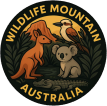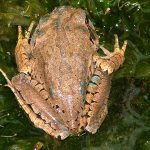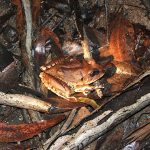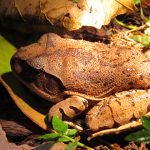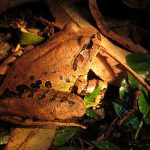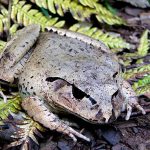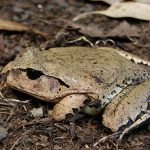GIANT BARRED FROG
Giant Barred Frog – A Voice of the Rainforest
About the Giant Barred Frog
The Giant barred frog (Mixophyes iteratus) is one of Australia’s largest and most remarkable frogs, with adults growing up to 11 cm long. At night, their golden eyes glimmer in the torchlight, and the deep, resonant call of the males echoes gently across rainforest streams. Encountering one feels like stepping into an ancient story of Australia’s wilderness – a reminder of how much life depends on the rhythm of rain, forest, and water.
Appearance and Behaviour
There is an earthy beauty to the Giant barred frog:
- Skin painted in shades of brown and gold,
- Bold dark stripes across strong hind legs that disappear into the forest floor like falling leaf shadows,
- Eyes luminous and watchful, mirrors of the rainforest at night.
By day, they vanish from view, hiding beneath leaf litter and fallen logs. By night, they emerge with quiet purpose, leaping over moss, stones, and water, their calls weaving a song of life into the rainforest’s nocturnal chorus.
Habitat of the Giant Barred Frog
This species belongs to the subtropical and temperate rainforests of eastern Australia, where water sparkles through creeks lined with ferns and towering trees. Found from south-eastern Queensland to north-eastern New South Wales, they depend on:
- Cool, shaded rainforest floors
- Flowing streams for breeding
- Untamed habitat rich in shelter and prey
When you stand in such a forest and hear their distinct call, you are listening to the pulse of the ecosystem itself.
Diet: What Do Giant Barred Frogs Eat?
The Giant barred frog is a creature shaped by instinct and opportunity.
- They strike at insects and worms with lightning speed.
- They swallow beetles, crickets, and even small vertebrates whole.
- Their long, sticky tongue is a marvel of evolution, allowing them to snatch food in an instant.
Watching them feed reminds us how finely balanced the rainforest food web is, with each creature playing a part in sustaining the whole.
Breeding and Life Cycle
As the warmth of spring and summer rains arrives, Giant barred frogs drift closer to water. Males fill the air with deep, resonant calls – “wark-wark-wark” – that roll like thunder through the undergrowth.
Females answer, and within pools and gentle currents, the next generation begins. Large, strong tadpoles drift beneath the water’s surface, growing steadily until they shed their underwater lives and take their first leap into the forest as young frogs. Each voice that joins the chorus strengthens the life of the rainforest.
Conservation Status of the Giant Barred Frog
The Giant barred frog is now listed as Endangered, and its story is one of both beauty and fragility.
- Rainforests cleared for farmland and development have stripped away its home.
- Disease like chytridiomycosis spreads silently, devastating populations.
- Invasive predators threaten eggs, tadpoles, and adults alike.
Their decline is not just the loss of one species – it is the silencing of a rainforest voice. As an indicator species, when they vanish, the health of the entire forest is in danger. Protecting them means protecting a web of life far beyond their own.
Key Facts at a Glance
| Feature | Details |
|---|---|
| Scientific name | Mixophyes iteratus |
| Size | Up to 11 cm long |
| Distribution | SE Queensland, NE New South Wales |
| Habitat | Rainforests near streams and creeks |
| Diet | Insects, worms, small vertebrates |
| Breeding season | Late spring to summer |
| Status | Endangered |
| Role in ecosystem | Indicator species for rainforest health |
Why Protect the Giant Barred Frog?
The Giant barred frog is more than an amphibian – it is a symbol of the rainforest’s hidden wonders. Its golden eyes and deep, rolling call remind us of what we stand to lose if we allow Australia’s rainforests to fade.
Protecting this species means:
- Keeping the rainforest chorus alive
- Preserving waterways that sustain both people and wildlife
- Passing on the richness of biodiversity to future generations
Their survival depends not only on conservation science but also on our willingness to care. By learning, sharing, and protecting, we give the rainforest – and the Giant barred frog – a chance to thrive once more.
